Business Growth Plan: Opportunity, Funding, Scaling & Exit Options
VerifiedAdded on 2023/06/30
|26
|5821
|50
Report
AI Summary
This report provides a comprehensive analysis of planning for growth in a small business context. It begins by evaluating key considerations for growth opportunities, such as competitive advantage, new products and services, and innovation, using frameworks like Porter's Five Forces and the BCG Matrix. The report then assesses opportunities for growth using Ansoff's growth vector matrix, including market penetration, product development, market development, and diversification. A detailed assessment of potential funding sources, including bank loans, crowdfunding, peer-to-peer lending, angel finance, and venture finance, is provided, outlining the benefits and drawbacks of each. The report includes a business plan for growth using the example of Ades, a wholesale groceries shop, incorporating financial information and strategic objectives for scaling up. Finally, it assesses exit or succession options for a small business, such as selling or floating the business, and company valuation, explaining the benefits and drawbacks of each option.

Unit 42: Planning for Growth
Submitted
By
1 | P a g e
Submitted
By
1 | P a g e
Paraphrase This Document
Need a fresh take? Get an instant paraphrase of this document with our AI Paraphraser
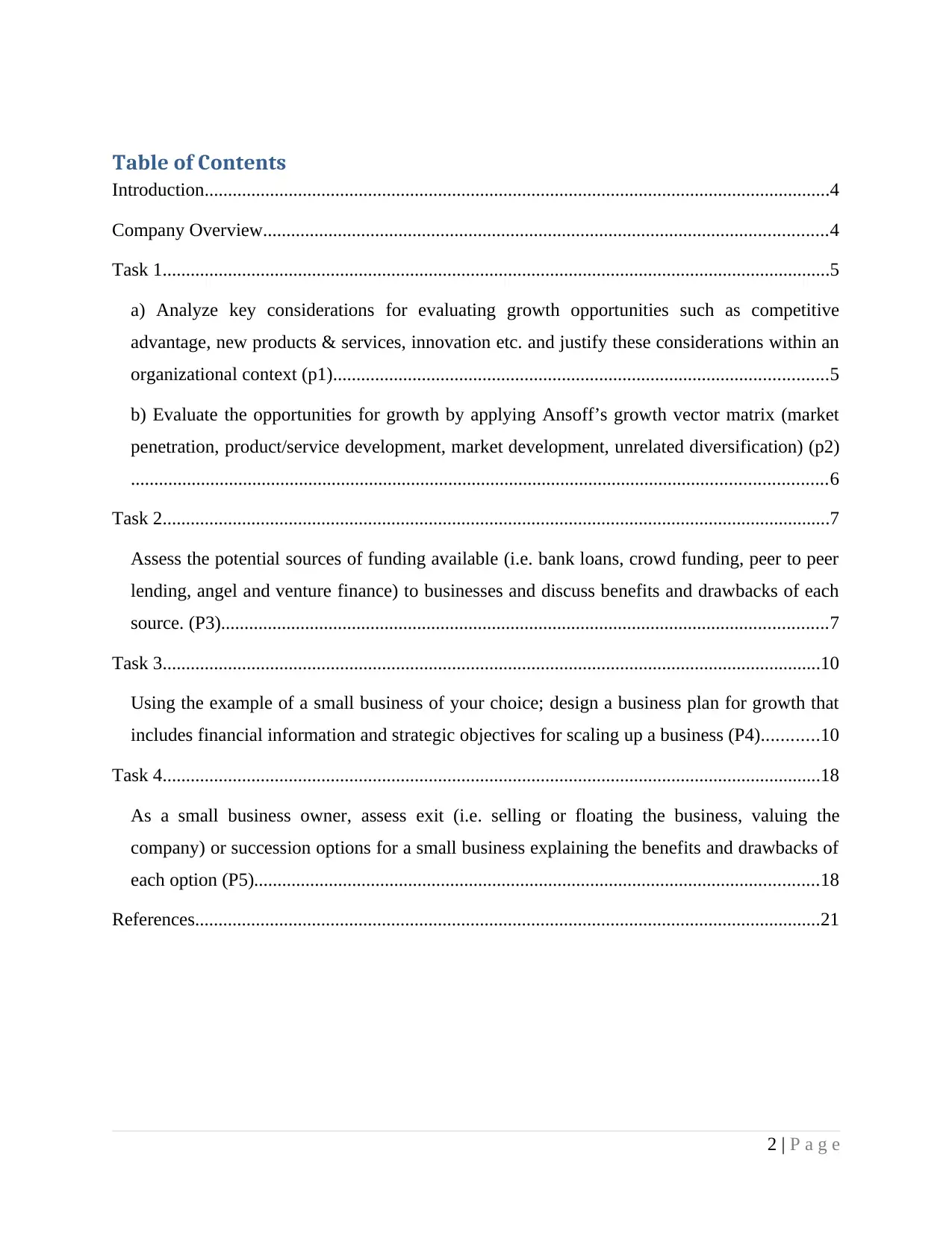
Table of Contents
Introduction......................................................................................................................................4
Company Overview.........................................................................................................................4
Task 1...............................................................................................................................................5
a) Analyze key considerations for evaluating growth opportunities such as competitive
advantage, new products & services, innovation etc. and justify these considerations within an
organizational context (p1)..........................................................................................................5
b) Evaluate the opportunities for growth by applying Ansoff’s growth vector matrix (market
penetration, product/service development, market development, unrelated diversification) (p2)
.....................................................................................................................................................6
Task 2...............................................................................................................................................7
Assess the potential sources of funding available (i.e. bank loans, crowd funding, peer to peer
lending, angel and venture finance) to businesses and discuss benefits and drawbacks of each
source. (P3)..................................................................................................................................7
Task 3.............................................................................................................................................10
Using the example of a small business of your choice; design a business plan for growth that
includes financial information and strategic objectives for scaling up a business (P4)............10
Task 4.............................................................................................................................................18
As a small business owner, assess exit (i.e. selling or floating the business, valuing the
company) or succession options for a small business explaining the benefits and drawbacks of
each option (P5).........................................................................................................................18
References......................................................................................................................................21
2 | P a g e
Introduction......................................................................................................................................4
Company Overview.........................................................................................................................4
Task 1...............................................................................................................................................5
a) Analyze key considerations for evaluating growth opportunities such as competitive
advantage, new products & services, innovation etc. and justify these considerations within an
organizational context (p1)..........................................................................................................5
b) Evaluate the opportunities for growth by applying Ansoff’s growth vector matrix (market
penetration, product/service development, market development, unrelated diversification) (p2)
.....................................................................................................................................................6
Task 2...............................................................................................................................................7
Assess the potential sources of funding available (i.e. bank loans, crowd funding, peer to peer
lending, angel and venture finance) to businesses and discuss benefits and drawbacks of each
source. (P3)..................................................................................................................................7
Task 3.............................................................................................................................................10
Using the example of a small business of your choice; design a business plan for growth that
includes financial information and strategic objectives for scaling up a business (P4)............10
Task 4.............................................................................................................................................18
As a small business owner, assess exit (i.e. selling or floating the business, valuing the
company) or succession options for a small business explaining the benefits and drawbacks of
each option (P5).........................................................................................................................18
References......................................................................................................................................21
2 | P a g e
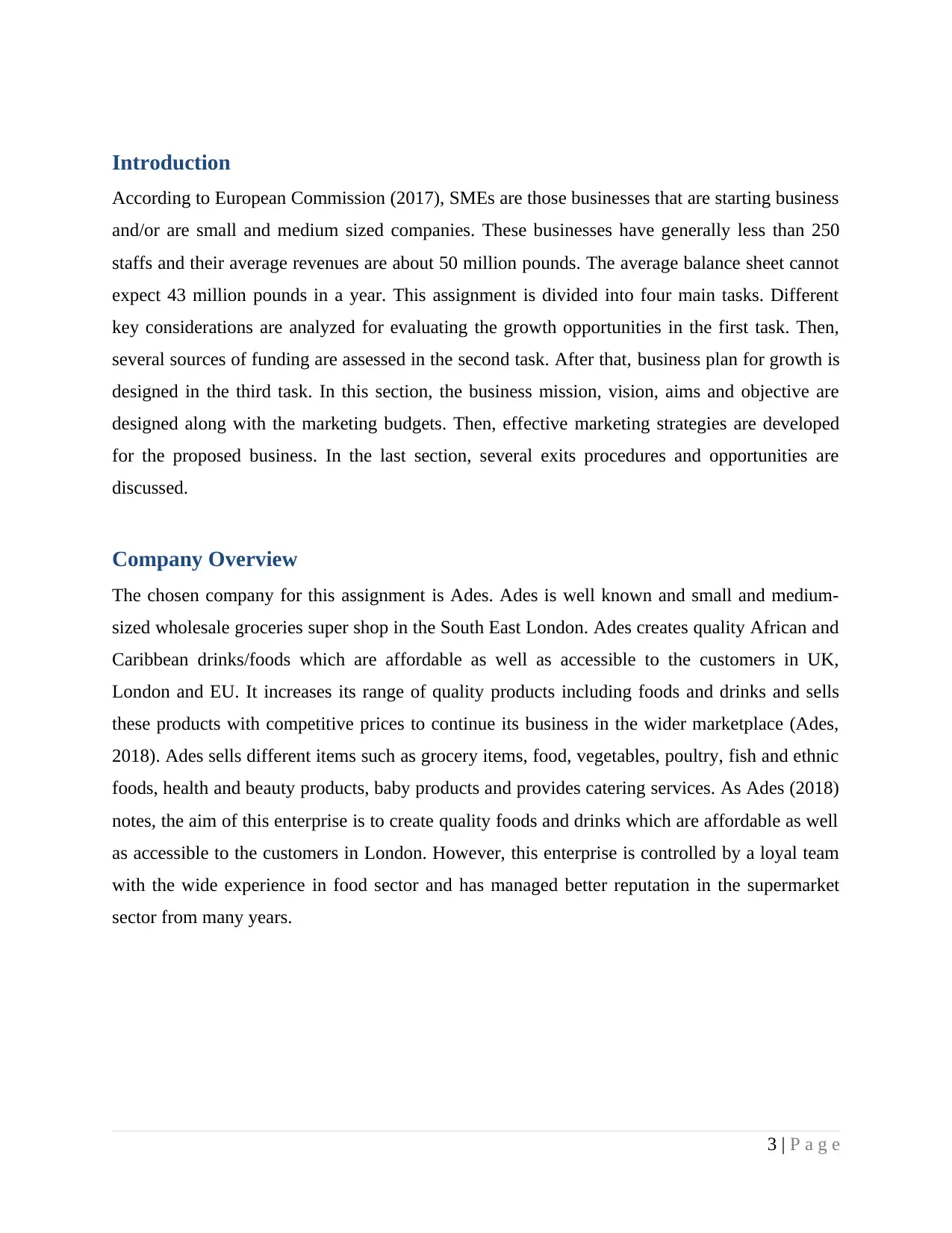
Introduction
According to European Commission (2017), SMEs are those businesses that are starting business
and/or are small and medium sized companies. These businesses have generally less than 250
staffs and their average revenues are about 50 million pounds. The average balance sheet cannot
expect 43 million pounds in a year. This assignment is divided into four main tasks. Different
key considerations are analyzed for evaluating the growth opportunities in the first task. Then,
several sources of funding are assessed in the second task. After that, business plan for growth is
designed in the third task. In this section, the business mission, vision, aims and objective are
designed along with the marketing budgets. Then, effective marketing strategies are developed
for the proposed business. In the last section, several exits procedures and opportunities are
discussed.
Company Overview
The chosen company for this assignment is Ades. Ades is well known and small and medium-
sized wholesale groceries super shop in the South East London. Ades creates quality African and
Caribbean drinks/foods which are affordable as well as accessible to the customers in UK,
London and EU. It increases its range of quality products including foods and drinks and sells
these products with competitive prices to continue its business in the wider marketplace (Ades,
2018). Ades sells different items such as grocery items, food, vegetables, poultry, fish and ethnic
foods, health and beauty products, baby products and provides catering services. As Ades (2018)
notes, the aim of this enterprise is to create quality foods and drinks which are affordable as well
as accessible to the customers in London. However, this enterprise is controlled by a loyal team
with the wide experience in food sector and has managed better reputation in the supermarket
sector from many years.
3 | P a g e
According to European Commission (2017), SMEs are those businesses that are starting business
and/or are small and medium sized companies. These businesses have generally less than 250
staffs and their average revenues are about 50 million pounds. The average balance sheet cannot
expect 43 million pounds in a year. This assignment is divided into four main tasks. Different
key considerations are analyzed for evaluating the growth opportunities in the first task. Then,
several sources of funding are assessed in the second task. After that, business plan for growth is
designed in the third task. In this section, the business mission, vision, aims and objective are
designed along with the marketing budgets. Then, effective marketing strategies are developed
for the proposed business. In the last section, several exits procedures and opportunities are
discussed.
Company Overview
The chosen company for this assignment is Ades. Ades is well known and small and medium-
sized wholesale groceries super shop in the South East London. Ades creates quality African and
Caribbean drinks/foods which are affordable as well as accessible to the customers in UK,
London and EU. It increases its range of quality products including foods and drinks and sells
these products with competitive prices to continue its business in the wider marketplace (Ades,
2018). Ades sells different items such as grocery items, food, vegetables, poultry, fish and ethnic
foods, health and beauty products, baby products and provides catering services. As Ades (2018)
notes, the aim of this enterprise is to create quality foods and drinks which are affordable as well
as accessible to the customers in London. However, this enterprise is controlled by a loyal team
with the wide experience in food sector and has managed better reputation in the supermarket
sector from many years.
3 | P a g e
⊘ This is a preview!⊘
Do you want full access?
Subscribe today to unlock all pages.

Trusted by 1+ million students worldwide
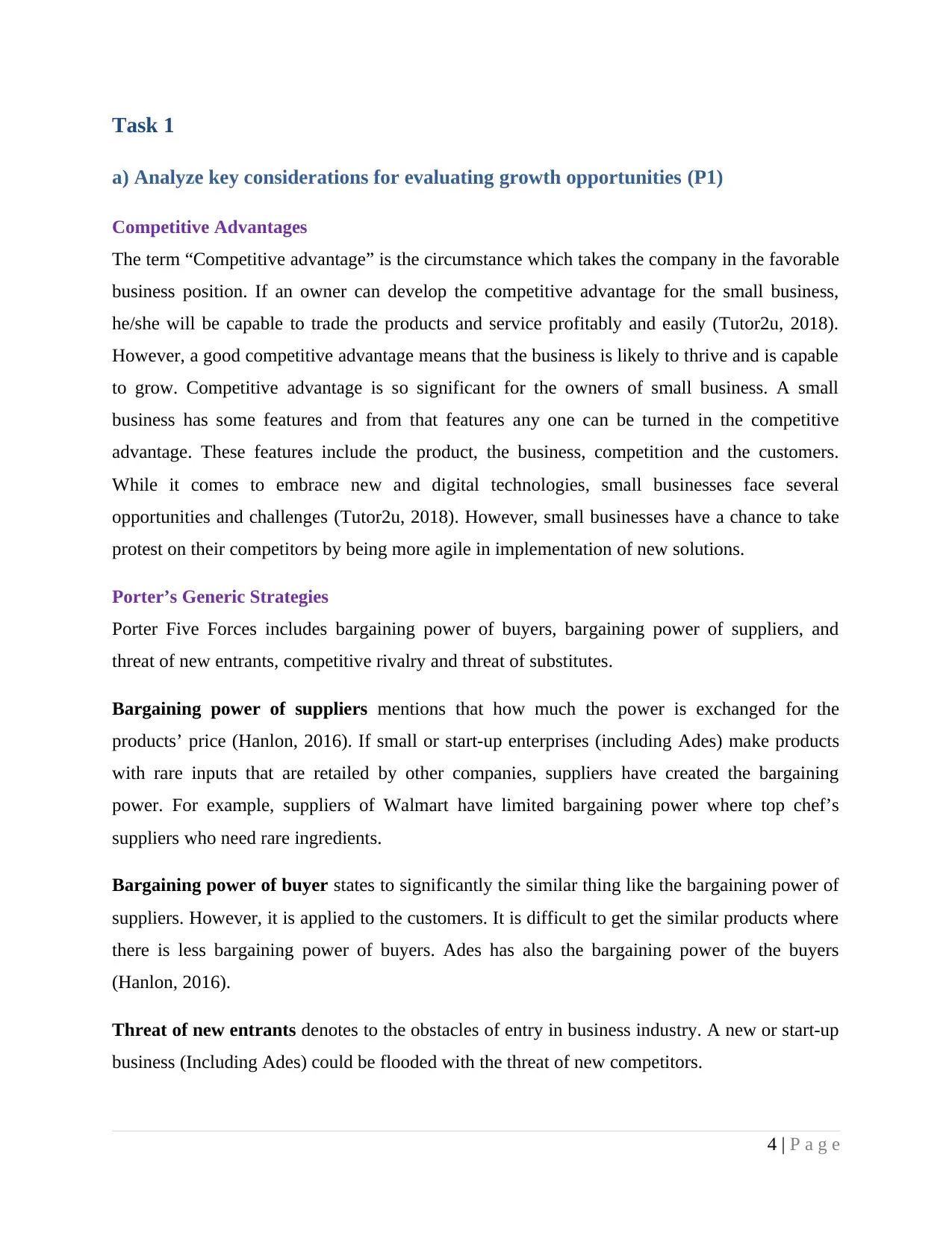
Task 1
a) Analyze key considerations for evaluating growth opportunities (P1)
Competitive Advantages
The term “Competitive advantage” is the circumstance which takes the company in the favorable
business position. If an owner can develop the competitive advantage for the small business,
he/she will be capable to trade the products and service profitably and easily (Tutor2u, 2018).
However, a good competitive advantage means that the business is likely to thrive and is capable
to grow. Competitive advantage is so significant for the owners of small business. A small
business has some features and from that features any one can be turned in the competitive
advantage. These features include the product, the business, competition and the customers.
While it comes to embrace new and digital technologies, small businesses face several
opportunities and challenges (Tutor2u, 2018). However, small businesses have a chance to take
protest on their competitors by being more agile in implementation of new solutions.
Porter’s Generic Strategies
Porter Five Forces includes bargaining power of buyers, bargaining power of suppliers, and
threat of new entrants, competitive rivalry and threat of substitutes.
Bargaining power of suppliers mentions that how much the power is exchanged for the
products’ price (Hanlon, 2016). If small or start-up enterprises (including Ades) make products
with rare inputs that are retailed by other companies, suppliers have created the bargaining
power. For example, suppliers of Walmart have limited bargaining power where top chef’s
suppliers who need rare ingredients.
Bargaining power of buyer states to significantly the similar thing like the bargaining power of
suppliers. However, it is applied to the customers. It is difficult to get the similar products where
there is less bargaining power of buyers. Ades has also the bargaining power of the buyers
(Hanlon, 2016).
Threat of new entrants denotes to the obstacles of entry in business industry. A new or start-up
business (Including Ades) could be flooded with the threat of new competitors.
4 | P a g e
a) Analyze key considerations for evaluating growth opportunities (P1)
Competitive Advantages
The term “Competitive advantage” is the circumstance which takes the company in the favorable
business position. If an owner can develop the competitive advantage for the small business,
he/she will be capable to trade the products and service profitably and easily (Tutor2u, 2018).
However, a good competitive advantage means that the business is likely to thrive and is capable
to grow. Competitive advantage is so significant for the owners of small business. A small
business has some features and from that features any one can be turned in the competitive
advantage. These features include the product, the business, competition and the customers.
While it comes to embrace new and digital technologies, small businesses face several
opportunities and challenges (Tutor2u, 2018). However, small businesses have a chance to take
protest on their competitors by being more agile in implementation of new solutions.
Porter’s Generic Strategies
Porter Five Forces includes bargaining power of buyers, bargaining power of suppliers, and
threat of new entrants, competitive rivalry and threat of substitutes.
Bargaining power of suppliers mentions that how much the power is exchanged for the
products’ price (Hanlon, 2016). If small or start-up enterprises (including Ades) make products
with rare inputs that are retailed by other companies, suppliers have created the bargaining
power. For example, suppliers of Walmart have limited bargaining power where top chef’s
suppliers who need rare ingredients.
Bargaining power of buyer states to significantly the similar thing like the bargaining power of
suppliers. However, it is applied to the customers. It is difficult to get the similar products where
there is less bargaining power of buyers. Ades has also the bargaining power of the buyers
(Hanlon, 2016).
Threat of new entrants denotes to the obstacles of entry in business industry. A new or start-up
business (Including Ades) could be flooded with the threat of new competitors.
4 | P a g e
Paraphrase This Document
Need a fresh take? Get an instant paraphrase of this document with our AI Paraphraser
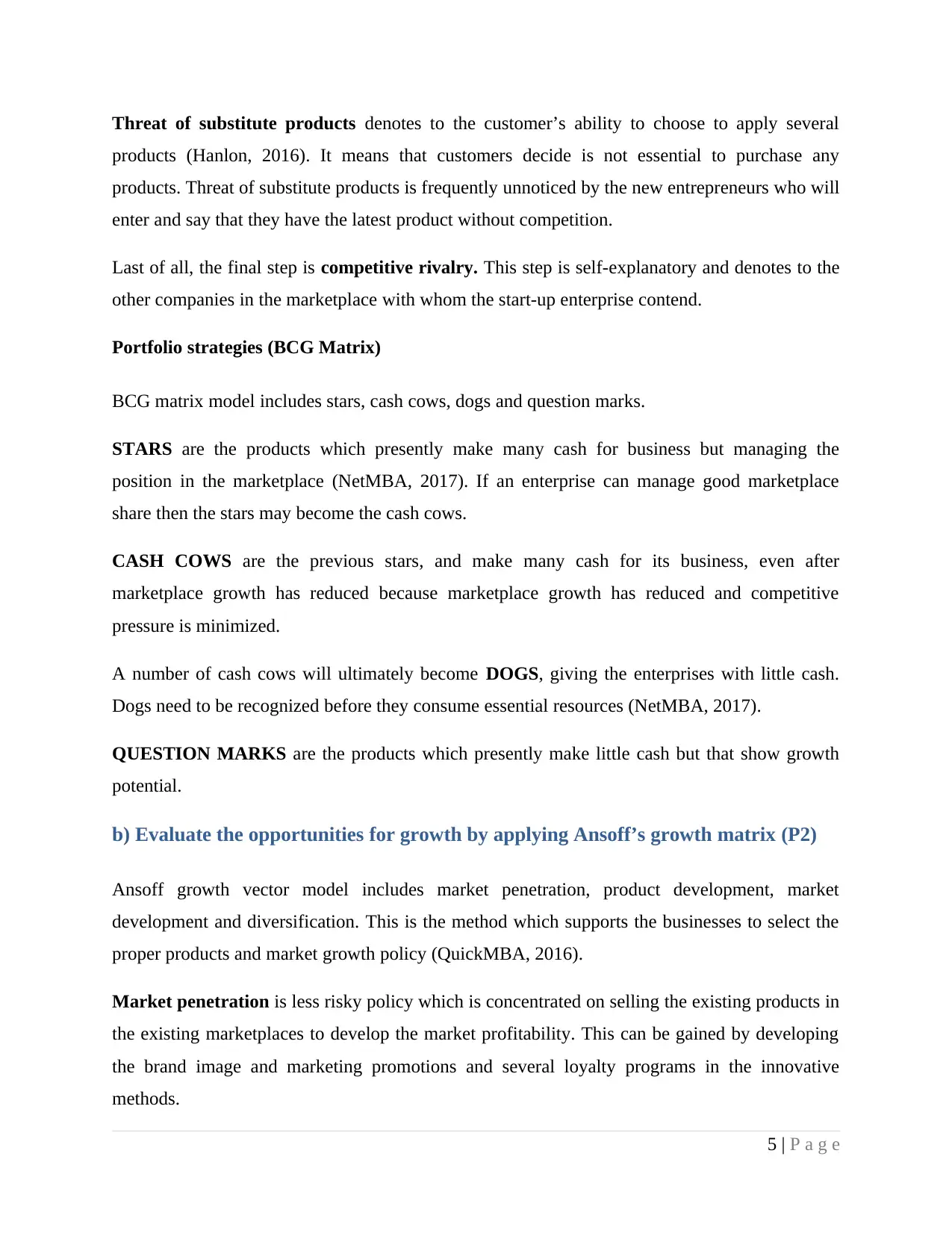
Threat of substitute products denotes to the customer’s ability to choose to apply several
products (Hanlon, 2016). It means that customers decide is not essential to purchase any
products. Threat of substitute products is frequently unnoticed by the new entrepreneurs who will
enter and say that they have the latest product without competition.
Last of all, the final step is competitive rivalry. This step is self-explanatory and denotes to the
other companies in the marketplace with whom the start-up enterprise contend.
Portfolio strategies (BCG Matrix)
BCG matrix model includes stars, cash cows, dogs and question marks.
STARS are the products which presently make many cash for business but managing the
position in the marketplace (NetMBA, 2017). If an enterprise can manage good marketplace
share then the stars may become the cash cows.
CASH COWS are the previous stars, and make many cash for its business, even after
marketplace growth has reduced because marketplace growth has reduced and competitive
pressure is minimized.
A number of cash cows will ultimately become DOGS, giving the enterprises with little cash.
Dogs need to be recognized before they consume essential resources (NetMBA, 2017).
QUESTION MARKS are the products which presently make little cash but that show growth
potential.
b) Evaluate the opportunities for growth by applying Ansoff’s growth matrix (P2)
Ansoff growth vector model includes market penetration, product development, market
development and diversification. This is the method which supports the businesses to select the
proper products and market growth policy (QuickMBA, 2016).
Market penetration is less risky policy which is concentrated on selling the existing products in
the existing marketplaces to develop the market profitability. This can be gained by developing
the brand image and marketing promotions and several loyalty programs in the innovative
methods.
5 | P a g e
products (Hanlon, 2016). It means that customers decide is not essential to purchase any
products. Threat of substitute products is frequently unnoticed by the new entrepreneurs who will
enter and say that they have the latest product without competition.
Last of all, the final step is competitive rivalry. This step is self-explanatory and denotes to the
other companies in the marketplace with whom the start-up enterprise contend.
Portfolio strategies (BCG Matrix)
BCG matrix model includes stars, cash cows, dogs and question marks.
STARS are the products which presently make many cash for business but managing the
position in the marketplace (NetMBA, 2017). If an enterprise can manage good marketplace
share then the stars may become the cash cows.
CASH COWS are the previous stars, and make many cash for its business, even after
marketplace growth has reduced because marketplace growth has reduced and competitive
pressure is minimized.
A number of cash cows will ultimately become DOGS, giving the enterprises with little cash.
Dogs need to be recognized before they consume essential resources (NetMBA, 2017).
QUESTION MARKS are the products which presently make little cash but that show growth
potential.
b) Evaluate the opportunities for growth by applying Ansoff’s growth matrix (P2)
Ansoff growth vector model includes market penetration, product development, market
development and diversification. This is the method which supports the businesses to select the
proper products and market growth policy (QuickMBA, 2016).
Market penetration is less risky policy which is concentrated on selling the existing products in
the existing marketplaces to develop the market profitability. This can be gained by developing
the brand image and marketing promotions and several loyalty programs in the innovative
methods.
5 | P a g e
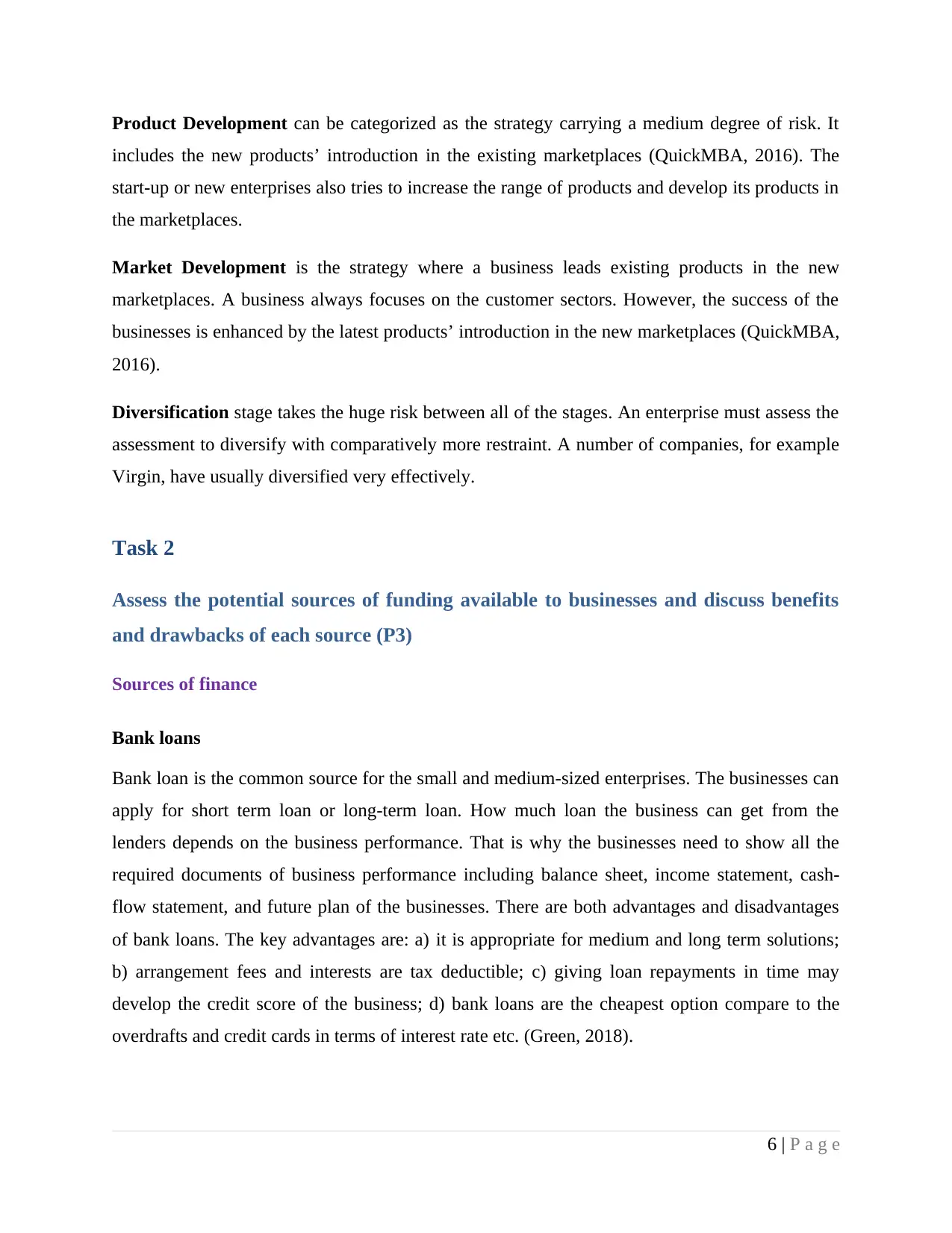
Product Development can be categorized as the strategy carrying a medium degree of risk. It
includes the new products’ introduction in the existing marketplaces (QuickMBA, 2016). The
start-up or new enterprises also tries to increase the range of products and develop its products in
the marketplaces.
Market Development is the strategy where a business leads existing products in the new
marketplaces. A business always focuses on the customer sectors. However, the success of the
businesses is enhanced by the latest products’ introduction in the new marketplaces (QuickMBA,
2016).
Diversification stage takes the huge risk between all of the stages. An enterprise must assess the
assessment to diversify with comparatively more restraint. A number of companies, for example
Virgin, have usually diversified very effectively.
Task 2
Assess the potential sources of funding available to businesses and discuss benefits
and drawbacks of each source (P3)
Sources of finance
Bank loans
Bank loan is the common source for the small and medium-sized enterprises. The businesses can
apply for short term loan or long-term loan. How much loan the business can get from the
lenders depends on the business performance. That is why the businesses need to show all the
required documents of business performance including balance sheet, income statement, cash-
flow statement, and future plan of the businesses. There are both advantages and disadvantages
of bank loans. The key advantages are: a) it is appropriate for medium and long term solutions;
b) arrangement fees and interests are tax deductible; c) giving loan repayments in time may
develop the credit score of the business; d) bank loans are the cheapest option compare to the
overdrafts and credit cards in terms of interest rate etc. (Green, 2018).
6 | P a g e
includes the new products’ introduction in the existing marketplaces (QuickMBA, 2016). The
start-up or new enterprises also tries to increase the range of products and develop its products in
the marketplaces.
Market Development is the strategy where a business leads existing products in the new
marketplaces. A business always focuses on the customer sectors. However, the success of the
businesses is enhanced by the latest products’ introduction in the new marketplaces (QuickMBA,
2016).
Diversification stage takes the huge risk between all of the stages. An enterprise must assess the
assessment to diversify with comparatively more restraint. A number of companies, for example
Virgin, have usually diversified very effectively.
Task 2
Assess the potential sources of funding available to businesses and discuss benefits
and drawbacks of each source (P3)
Sources of finance
Bank loans
Bank loan is the common source for the small and medium-sized enterprises. The businesses can
apply for short term loan or long-term loan. How much loan the business can get from the
lenders depends on the business performance. That is why the businesses need to show all the
required documents of business performance including balance sheet, income statement, cash-
flow statement, and future plan of the businesses. There are both advantages and disadvantages
of bank loans. The key advantages are: a) it is appropriate for medium and long term solutions;
b) arrangement fees and interests are tax deductible; c) giving loan repayments in time may
develop the credit score of the business; d) bank loans are the cheapest option compare to the
overdrafts and credit cards in terms of interest rate etc. (Green, 2018).
6 | P a g e
⊘ This is a preview!⊘
Do you want full access?
Subscribe today to unlock all pages.

Trusted by 1+ million students worldwide
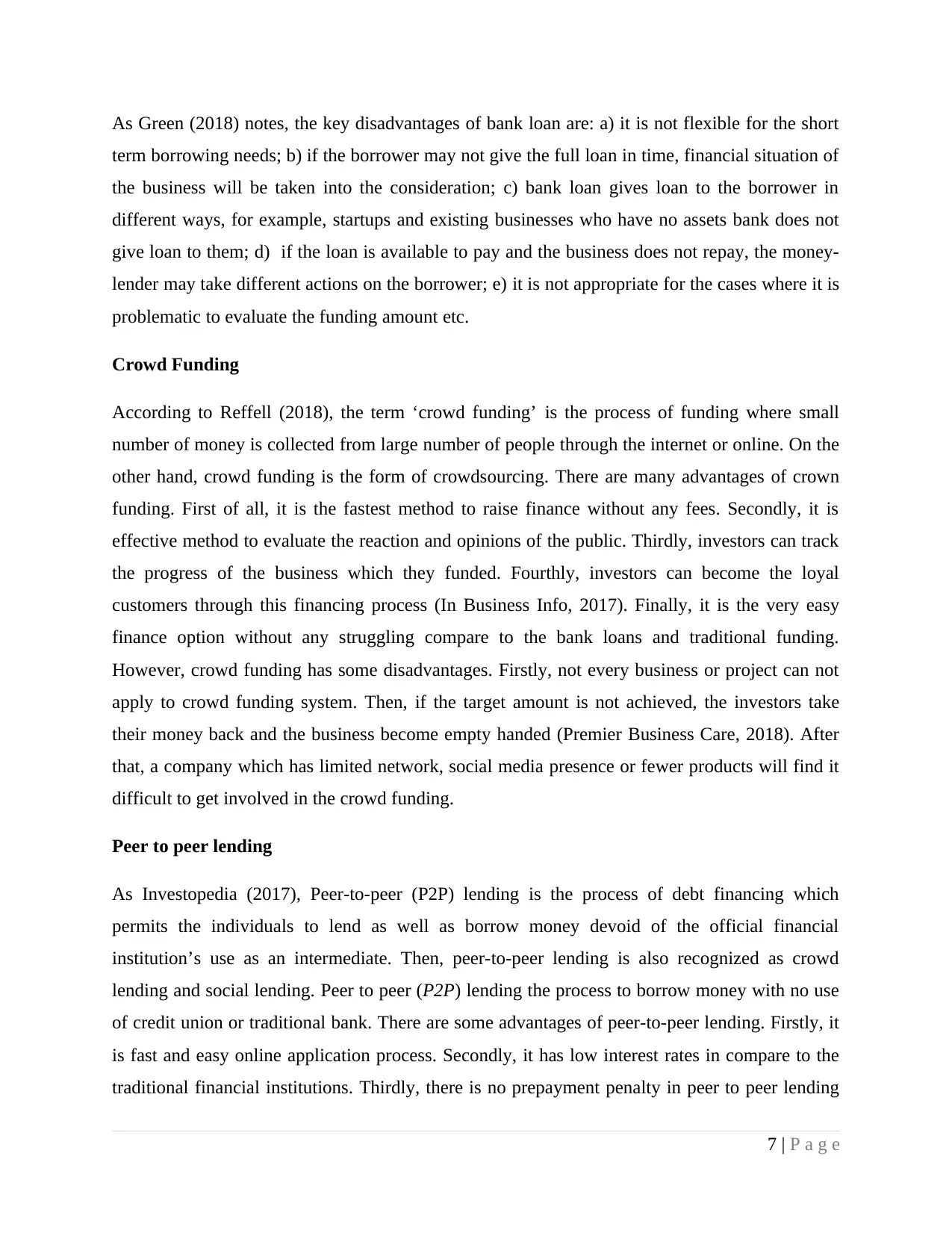
As Green (2018) notes, the key disadvantages of bank loan are: a) it is not flexible for the short
term borrowing needs; b) if the borrower may not give the full loan in time, financial situation of
the business will be taken into the consideration; c) bank loan gives loan to the borrower in
different ways, for example, startups and existing businesses who have no assets bank does not
give loan to them; d) if the loan is available to pay and the business does not repay, the money-
lender may take different actions on the borrower; e) it is not appropriate for the cases where it is
problematic to evaluate the funding amount etc.
Crowd Funding
According to Reffell (2018), the term ‘crowd funding’ is the process of funding where small
number of money is collected from large number of people through the internet or online. On the
other hand, crowd funding is the form of crowdsourcing. There are many advantages of crown
funding. First of all, it is the fastest method to raise finance without any fees. Secondly, it is
effective method to evaluate the reaction and opinions of the public. Thirdly, investors can track
the progress of the business which they funded. Fourthly, investors can become the loyal
customers through this financing process (In Business Info, 2017). Finally, it is the very easy
finance option without any struggling compare to the bank loans and traditional funding.
However, crowd funding has some disadvantages. Firstly, not every business or project can not
apply to crowd funding system. Then, if the target amount is not achieved, the investors take
their money back and the business become empty handed (Premier Business Care, 2018). After
that, a company which has limited network, social media presence or fewer products will find it
difficult to get involved in the crowd funding.
Peer to peer lending
As Investopedia (2017), Peer-to-peer (P2P) lending is the process of debt financing which
permits the individuals to lend as well as borrow money devoid of the official financial
institution’s use as an intermediate. Then, peer-to-peer lending is also recognized as crowd
lending and social lending. Peer to peer (P2P) lending the process to borrow money with no use
of credit union or traditional bank. There are some advantages of peer-to-peer lending. Firstly, it
is fast and easy online application process. Secondly, it has low interest rates in compare to the
traditional financial institutions. Thirdly, there is no prepayment penalty in peer to peer lending
7 | P a g e
term borrowing needs; b) if the borrower may not give the full loan in time, financial situation of
the business will be taken into the consideration; c) bank loan gives loan to the borrower in
different ways, for example, startups and existing businesses who have no assets bank does not
give loan to them; d) if the loan is available to pay and the business does not repay, the money-
lender may take different actions on the borrower; e) it is not appropriate for the cases where it is
problematic to evaluate the funding amount etc.
Crowd Funding
According to Reffell (2018), the term ‘crowd funding’ is the process of funding where small
number of money is collected from large number of people through the internet or online. On the
other hand, crowd funding is the form of crowdsourcing. There are many advantages of crown
funding. First of all, it is the fastest method to raise finance without any fees. Secondly, it is
effective method to evaluate the reaction and opinions of the public. Thirdly, investors can track
the progress of the business which they funded. Fourthly, investors can become the loyal
customers through this financing process (In Business Info, 2017). Finally, it is the very easy
finance option without any struggling compare to the bank loans and traditional funding.
However, crowd funding has some disadvantages. Firstly, not every business or project can not
apply to crowd funding system. Then, if the target amount is not achieved, the investors take
their money back and the business become empty handed (Premier Business Care, 2018). After
that, a company which has limited network, social media presence or fewer products will find it
difficult to get involved in the crowd funding.
Peer to peer lending
As Investopedia (2017), Peer-to-peer (P2P) lending is the process of debt financing which
permits the individuals to lend as well as borrow money devoid of the official financial
institution’s use as an intermediate. Then, peer-to-peer lending is also recognized as crowd
lending and social lending. Peer to peer (P2P) lending the process to borrow money with no use
of credit union or traditional bank. There are some advantages of peer-to-peer lending. Firstly, it
is fast and easy online application process. Secondly, it has low interest rates in compare to the
traditional financial institutions. Thirdly, there is no prepayment penalty in peer to peer lending
7 | P a g e
Paraphrase This Document
Need a fresh take? Get an instant paraphrase of this document with our AI Paraphraser
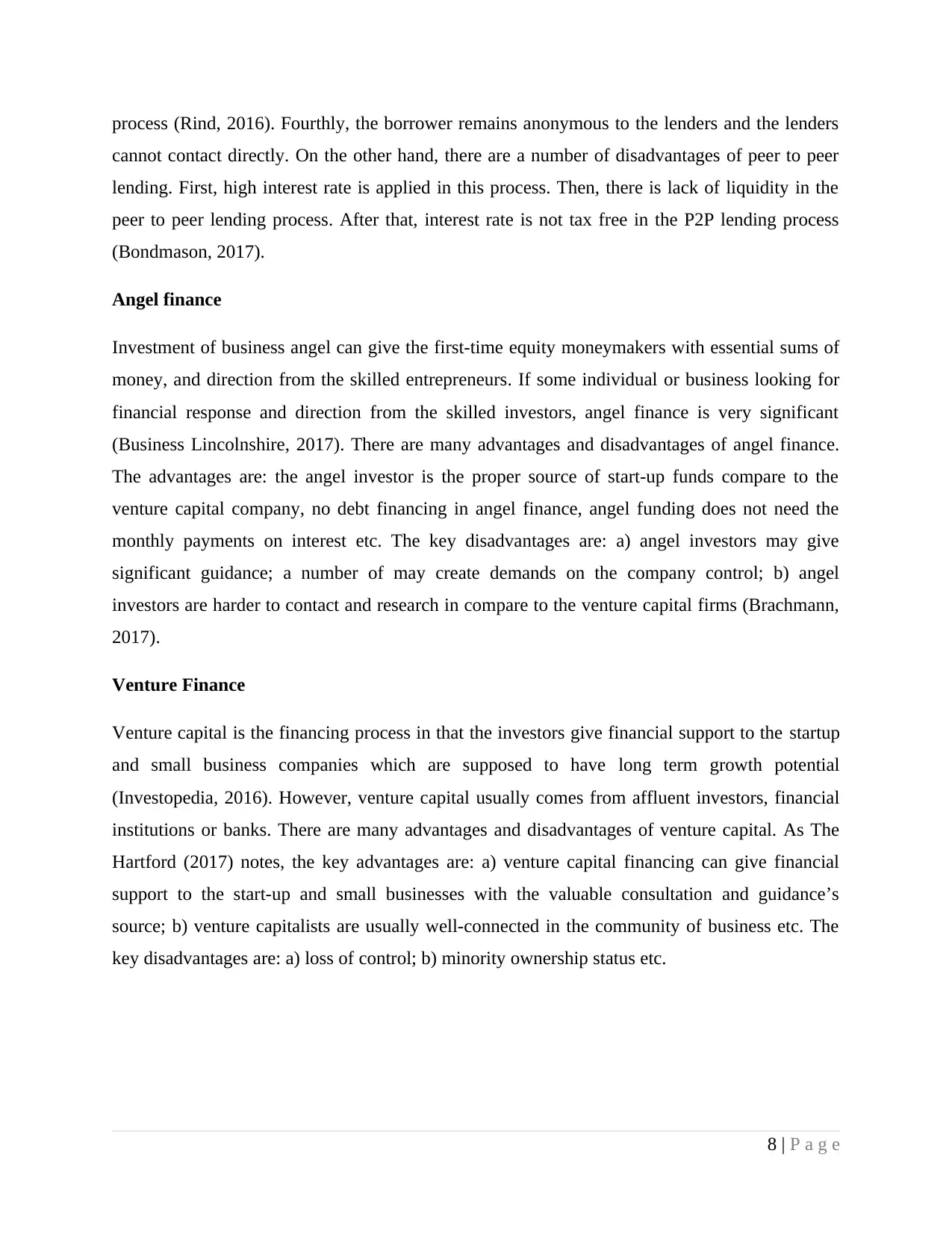
process (Rind, 2016). Fourthly, the borrower remains anonymous to the lenders and the lenders
cannot contact directly. On the other hand, there are a number of disadvantages of peer to peer
lending. First, high interest rate is applied in this process. Then, there is lack of liquidity in the
peer to peer lending process. After that, interest rate is not tax free in the P2P lending process
(Bondmason, 2017).
Angel finance
Investment of business angel can give the first-time equity moneymakers with essential sums of
money, and direction from the skilled entrepreneurs. If some individual or business looking for
financial response and direction from the skilled investors, angel finance is very significant
(Business Lincolnshire, 2017). There are many advantages and disadvantages of angel finance.
The advantages are: the angel investor is the proper source of start-up funds compare to the
venture capital company, no debt financing in angel finance, angel funding does not need the
monthly payments on interest etc. The key disadvantages are: a) angel investors may give
significant guidance; a number of may create demands on the company control; b) angel
investors are harder to contact and research in compare to the venture capital firms (Brachmann,
2017).
Venture Finance
Venture capital is the financing process in that the investors give financial support to the startup
and small business companies which are supposed to have long term growth potential
(Investopedia, 2016). However, venture capital usually comes from affluent investors, financial
institutions or banks. There are many advantages and disadvantages of venture capital. As The
Hartford (2017) notes, the key advantages are: a) venture capital financing can give financial
support to the start-up and small businesses with the valuable consultation and guidance’s
source; b) venture capitalists are usually well-connected in the community of business etc. The
key disadvantages are: a) loss of control; b) minority ownership status etc.
8 | P a g e
cannot contact directly. On the other hand, there are a number of disadvantages of peer to peer
lending. First, high interest rate is applied in this process. Then, there is lack of liquidity in the
peer to peer lending process. After that, interest rate is not tax free in the P2P lending process
(Bondmason, 2017).
Angel finance
Investment of business angel can give the first-time equity moneymakers with essential sums of
money, and direction from the skilled entrepreneurs. If some individual or business looking for
financial response and direction from the skilled investors, angel finance is very significant
(Business Lincolnshire, 2017). There are many advantages and disadvantages of angel finance.
The advantages are: the angel investor is the proper source of start-up funds compare to the
venture capital company, no debt financing in angel finance, angel funding does not need the
monthly payments on interest etc. The key disadvantages are: a) angel investors may give
significant guidance; a number of may create demands on the company control; b) angel
investors are harder to contact and research in compare to the venture capital firms (Brachmann,
2017).
Venture Finance
Venture capital is the financing process in that the investors give financial support to the startup
and small business companies which are supposed to have long term growth potential
(Investopedia, 2016). However, venture capital usually comes from affluent investors, financial
institutions or banks. There are many advantages and disadvantages of venture capital. As The
Hartford (2017) notes, the key advantages are: a) venture capital financing can give financial
support to the start-up and small businesses with the valuable consultation and guidance’s
source; b) venture capitalists are usually well-connected in the community of business etc. The
key disadvantages are: a) loss of control; b) minority ownership status etc.
8 | P a g e
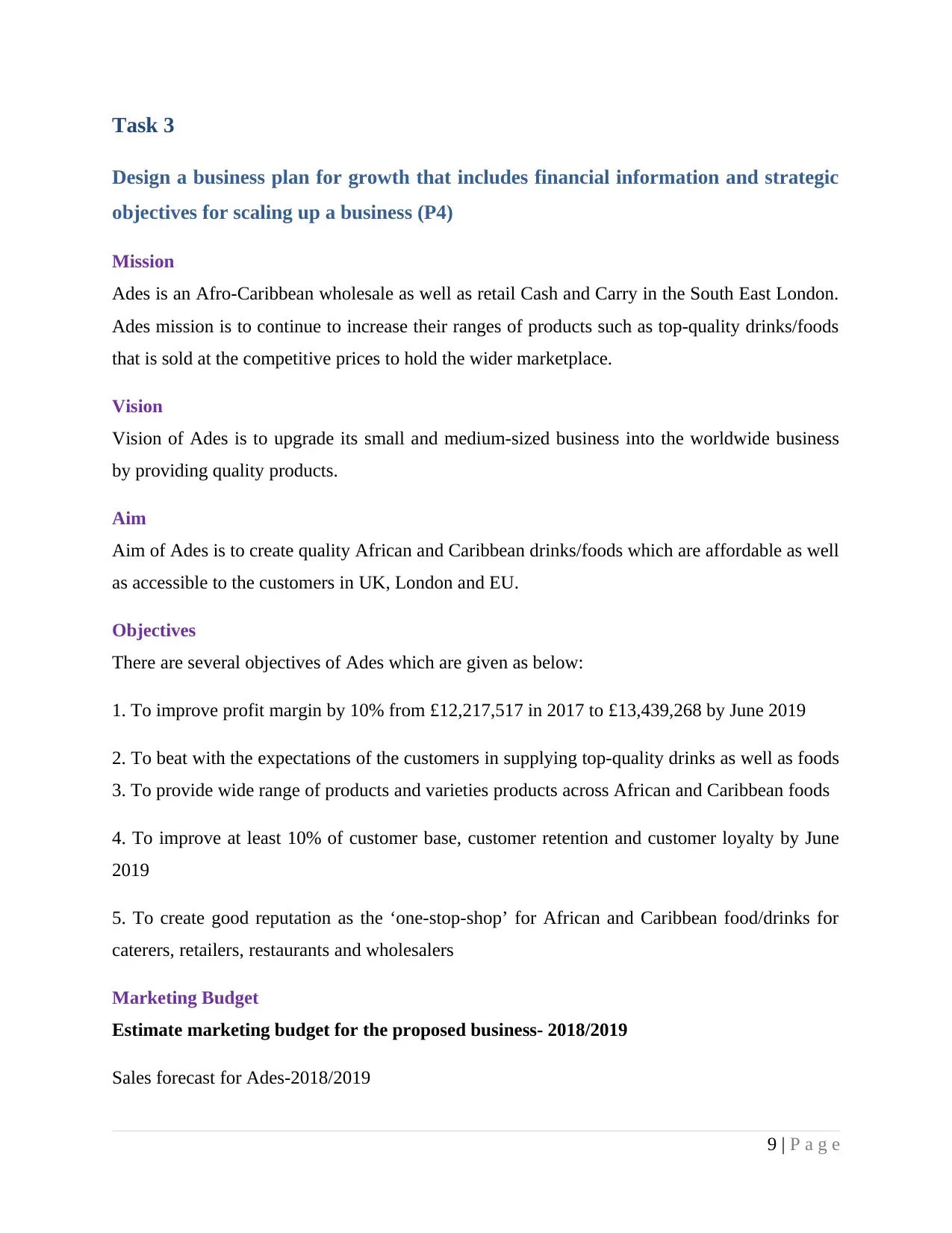
Task 3
Design a business plan for growth that includes financial information and strategic
objectives for scaling up a business (P4)
Mission
Ades is an Afro-Caribbean wholesale as well as retail Cash and Carry in the South East London.
Ades mission is to continue to increase their ranges of products such as top-quality drinks/foods
that is sold at the competitive prices to hold the wider marketplace.
Vision
Vision of Ades is to upgrade its small and medium-sized business into the worldwide business
by providing quality products.
Aim
Aim of Ades is to create quality African and Caribbean drinks/foods which are affordable as well
as accessible to the customers in UK, London and EU.
Objectives
There are several objectives of Ades which are given as below:
1. To improve profit margin by 10% from £12,217,517 in 2017 to £13,439,268 by June 2019
2. To beat with the expectations of the customers in supplying top-quality drinks as well as foods
3. To provide wide range of products and varieties products across African and Caribbean foods
4. To improve at least 10% of customer base, customer retention and customer loyalty by June
2019
5. To create good reputation as the ‘one-stop-shop’ for African and Caribbean food/drinks for
caterers, retailers, restaurants and wholesalers
Marketing Budget
Estimate marketing budget for the proposed business- 2018/2019
Sales forecast for Ades-2018/2019
9 | P a g e
Design a business plan for growth that includes financial information and strategic
objectives for scaling up a business (P4)
Mission
Ades is an Afro-Caribbean wholesale as well as retail Cash and Carry in the South East London.
Ades mission is to continue to increase their ranges of products such as top-quality drinks/foods
that is sold at the competitive prices to hold the wider marketplace.
Vision
Vision of Ades is to upgrade its small and medium-sized business into the worldwide business
by providing quality products.
Aim
Aim of Ades is to create quality African and Caribbean drinks/foods which are affordable as well
as accessible to the customers in UK, London and EU.
Objectives
There are several objectives of Ades which are given as below:
1. To improve profit margin by 10% from £12,217,517 in 2017 to £13,439,268 by June 2019
2. To beat with the expectations of the customers in supplying top-quality drinks as well as foods
3. To provide wide range of products and varieties products across African and Caribbean foods
4. To improve at least 10% of customer base, customer retention and customer loyalty by June
2019
5. To create good reputation as the ‘one-stop-shop’ for African and Caribbean food/drinks for
caterers, retailers, restaurants and wholesalers
Marketing Budget
Estimate marketing budget for the proposed business- 2018/2019
Sales forecast for Ades-2018/2019
9 | P a g e
⊘ This is a preview!⊘
Do you want full access?
Subscribe today to unlock all pages.

Trusted by 1+ million students worldwide
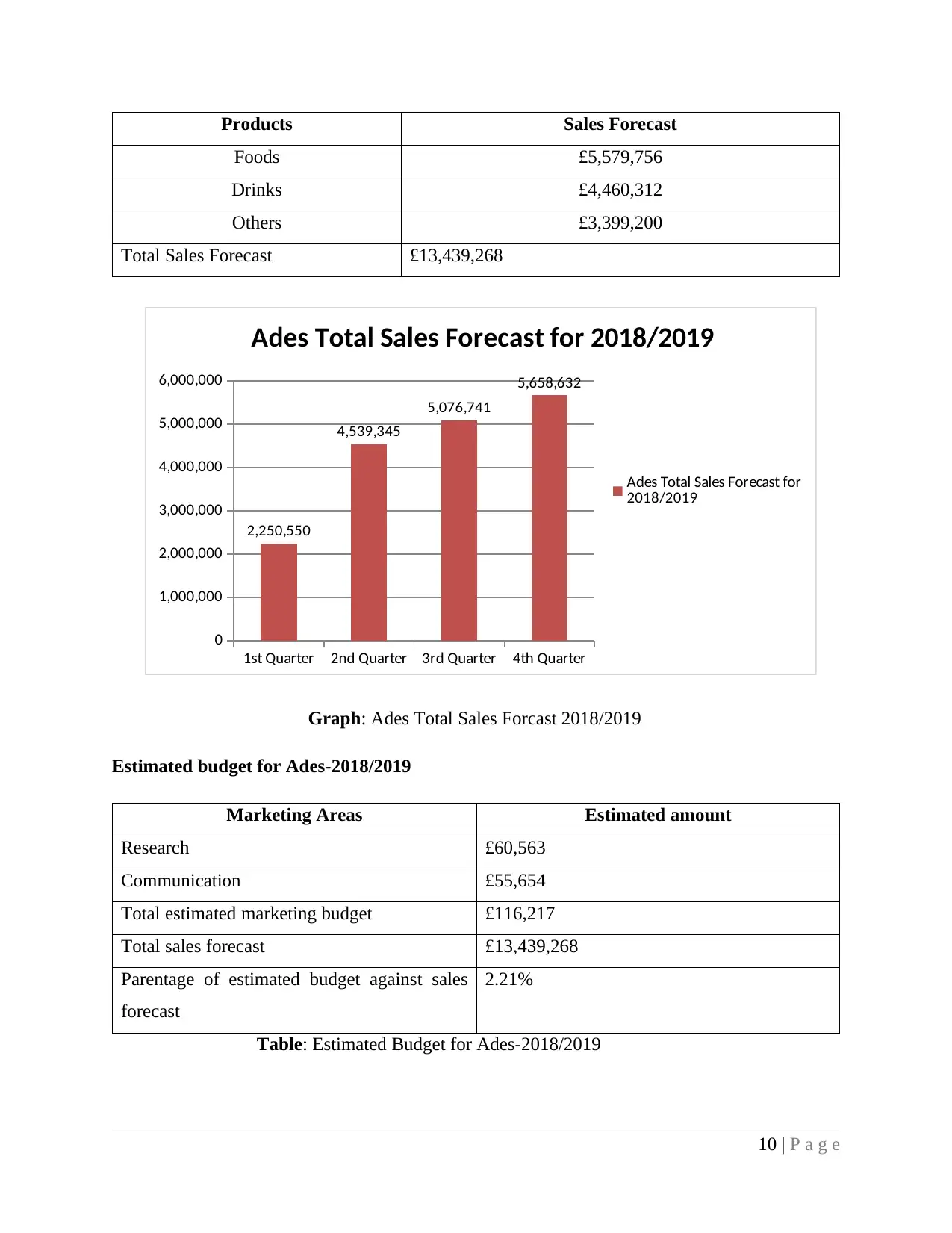
Products Sales Forecast
Foods £5,579,756
Drinks £4,460,312
Others £3,399,200
Total Sales Forecast £13,439,268
Graph: Ades Total Sales Forcast 2018/2019
Estimated budget for Ades-2018/2019
Marketing Areas Estimated amount
Research £60,563
Communication £55,654
Total estimated marketing budget £116,217
Total sales forecast £13,439,268
Parentage of estimated budget against sales
forecast
2.21%
Table: Estimated Budget for Ades-2018/2019
10 | P a g e
1st Quarter 2nd Quarter 3rd Quarter 4th Quarter
0
1,000,000
2,000,000
3,000,000
4,000,000
5,000,000
6,000,000
2,250,550
4,539,345
5,076,741
5,658,632
Ades Total Sales Forecast for 2018/2019
Ades Total Sales Forecast for
2018/2019
Foods £5,579,756
Drinks £4,460,312
Others £3,399,200
Total Sales Forecast £13,439,268
Graph: Ades Total Sales Forcast 2018/2019
Estimated budget for Ades-2018/2019
Marketing Areas Estimated amount
Research £60,563
Communication £55,654
Total estimated marketing budget £116,217
Total sales forecast £13,439,268
Parentage of estimated budget against sales
forecast
2.21%
Table: Estimated Budget for Ades-2018/2019
10 | P a g e
1st Quarter 2nd Quarter 3rd Quarter 4th Quarter
0
1,000,000
2,000,000
3,000,000
4,000,000
5,000,000
6,000,000
2,250,550
4,539,345
5,076,741
5,658,632
Ades Total Sales Forecast for 2018/2019
Ades Total Sales Forecast for
2018/2019
Paraphrase This Document
Need a fresh take? Get an instant paraphrase of this document with our AI Paraphraser
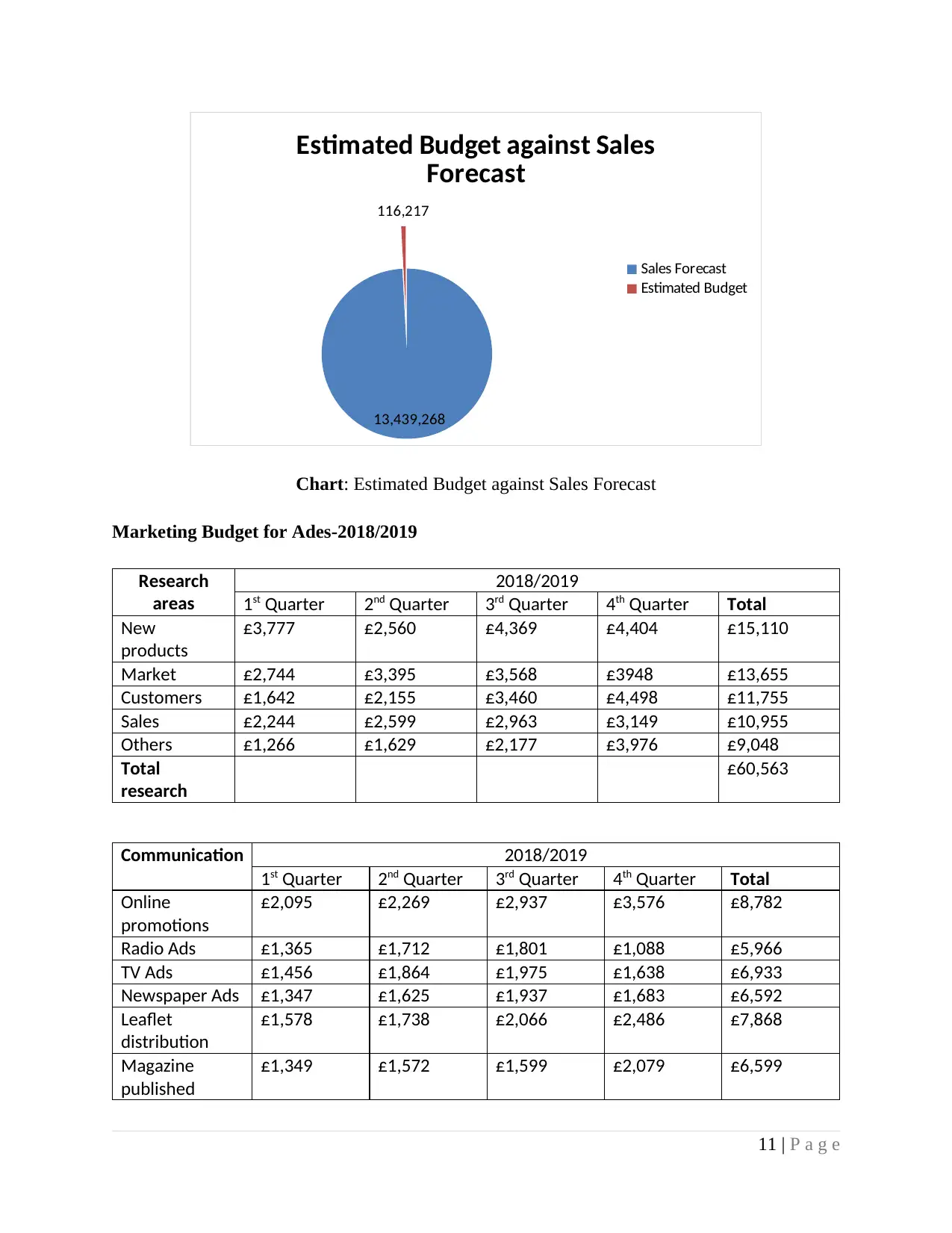
13,439,268
116,217
Estimated Budget against Sales
Forecast
Sales Forecast
Estimated Budget
Chart: Estimated Budget against Sales Forecast
Marketing Budget for Ades-2018/2019
Research
areas
2018/2019
1st Quarter 2nd Quarter 3rd Quarter 4th Quarter Total
New
products
£3,777 £2,560 £4,369 £4,404 £15,110
Market £2,744 £3,395 £3,568 £3948 £13,655
Customers £1,642 £2,155 £3,460 £4,498 £11,755
Sales £2,244 £2,599 £2,963 £3,149 £10,955
Others £1,266 £1,629 £2,177 £3,976 £9,048
Total
research
£60,563
Communication 2018/2019
1st Quarter 2nd Quarter 3rd Quarter 4th Quarter Total
Online
promotions
£2,095 £2,269 £2,937 £3,576 £8,782
Radio Ads £1,365 £1,712 £1,801 £1,088 £5,966
TV Ads £1,456 £1,864 £1,975 £1,638 £6,933
Newspaper Ads £1,347 £1,625 £1,937 £1,683 £6,592
Leaflet
distribution
£1,578 £1,738 £2,066 £2,486 £7,868
Magazine
published
£1,349 £1,572 £1,599 £2,079 £6,599
11 | P a g e
116,217
Estimated Budget against Sales
Forecast
Sales Forecast
Estimated Budget
Chart: Estimated Budget against Sales Forecast
Marketing Budget for Ades-2018/2019
Research
areas
2018/2019
1st Quarter 2nd Quarter 3rd Quarter 4th Quarter Total
New
products
£3,777 £2,560 £4,369 £4,404 £15,110
Market £2,744 £3,395 £3,568 £3948 £13,655
Customers £1,642 £2,155 £3,460 £4,498 £11,755
Sales £2,244 £2,599 £2,963 £3,149 £10,955
Others £1,266 £1,629 £2,177 £3,976 £9,048
Total
research
£60,563
Communication 2018/2019
1st Quarter 2nd Quarter 3rd Quarter 4th Quarter Total
Online
promotions
£2,095 £2,269 £2,937 £3,576 £8,782
Radio Ads £1,365 £1,712 £1,801 £1,088 £5,966
TV Ads £1,456 £1,864 £1,975 £1,638 £6,933
Newspaper Ads £1,347 £1,625 £1,937 £1,683 £6,592
Leaflet
distribution
£1,578 £1,738 £2,066 £2,486 £7,868
Magazine
published
£1,349 £1,572 £1,599 £2,079 £6,599
11 | P a g e
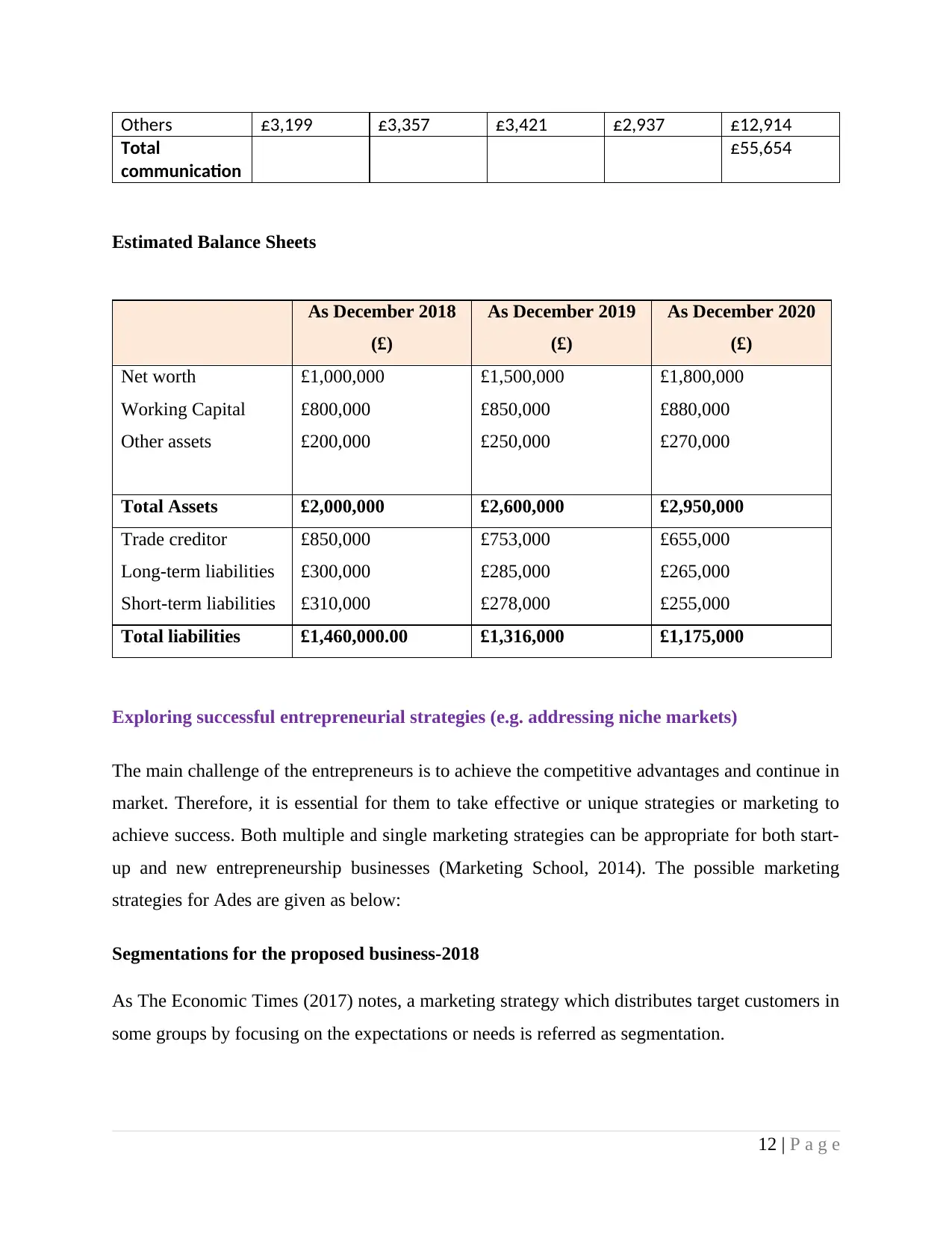
Others £3,199 £3,357 £3,421 £2,937 £12,914
Total
communication
£55,654
Estimated Balance Sheets
As December 2018
(£)
As December 2019
(£)
As December 2020
(£)
Net worth
Working Capital
Other assets
£1,000,000
£800,000
£200,000
£1,500,000
£850,000
£250,000
£1,800,000
£880,000
£270,000
Total Assets £2,000,000 £2,600,000 £2,950,000
Trade creditor
Long-term liabilities
Short-term liabilities
£850,000
£300,000
£310,000
£753,000
£285,000
£278,000
£655,000
£265,000
£255,000
Total liabilities £1,460,000.00 £1,316,000 £1,175,000
Exploring successful entrepreneurial strategies (e.g. addressing niche markets)
The main challenge of the entrepreneurs is to achieve the competitive advantages and continue in
market. Therefore, it is essential for them to take effective or unique strategies or marketing to
achieve success. Both multiple and single marketing strategies can be appropriate for both start-
up and new entrepreneurship businesses (Marketing School, 2014). The possible marketing
strategies for Ades are given as below:
Segmentations for the proposed business-2018
As The Economic Times (2017) notes, a marketing strategy which distributes target customers in
some groups by focusing on the expectations or needs is referred as segmentation.
12 | P a g e
Total
communication
£55,654
Estimated Balance Sheets
As December 2018
(£)
As December 2019
(£)
As December 2020
(£)
Net worth
Working Capital
Other assets
£1,000,000
£800,000
£200,000
£1,500,000
£850,000
£250,000
£1,800,000
£880,000
£270,000
Total Assets £2,000,000 £2,600,000 £2,950,000
Trade creditor
Long-term liabilities
Short-term liabilities
£850,000
£300,000
£310,000
£753,000
£285,000
£278,000
£655,000
£265,000
£255,000
Total liabilities £1,460,000.00 £1,316,000 £1,175,000
Exploring successful entrepreneurial strategies (e.g. addressing niche markets)
The main challenge of the entrepreneurs is to achieve the competitive advantages and continue in
market. Therefore, it is essential for them to take effective or unique strategies or marketing to
achieve success. Both multiple and single marketing strategies can be appropriate for both start-
up and new entrepreneurship businesses (Marketing School, 2014). The possible marketing
strategies for Ades are given as below:
Segmentations for the proposed business-2018
As The Economic Times (2017) notes, a marketing strategy which distributes target customers in
some groups by focusing on the expectations or needs is referred as segmentation.
12 | P a g e
⊘ This is a preview!⊘
Do you want full access?
Subscribe today to unlock all pages.

Trusted by 1+ million students worldwide
1 out of 26
Related Documents
Your All-in-One AI-Powered Toolkit for Academic Success.
+13062052269
info@desklib.com
Available 24*7 on WhatsApp / Email
![[object Object]](/_next/static/media/star-bottom.7253800d.svg)
Unlock your academic potential
Copyright © 2020–2025 A2Z Services. All Rights Reserved. Developed and managed by ZUCOL.



